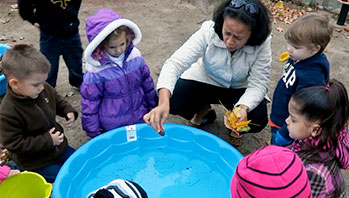- camera or cell phone camera
- clipboard
- paper
- pen
- pictures of ramps
- fast
- faster
- inclined plane
- ramp
- slant
- slide (v.)
- slow
- slower
MA Standards:
English Language Arts/Language/L.PK.MA.6: Use words and phrases acquired through conversations, listening to books read aloud, activities, and play.
MA Draft Standards:
Physical Sciences/Motion and Stability; Forces and Interaction/PS2.A:Plan and carry out investigations of the behaviors of moving things.
Physical Sciences/Motion and Stability; Forces and Interaction /PS2.B: Using evidence, discuss ideas about what is making something move the way it does and how some movements can be controlled. [Cause and Effect, Stability and Change]
Head Start Outcomes:
Logic and Reasoning/Reasoning and Problem Solving: Recognizes cause and effect relationships.
Science Knowledge/Scientific Skills and Method: Uses senses and tools, including technology, to gather information, investigate materials, and observe processes and relationships.
Science and Technology/Inquiry Skills 4: Record observations and share ideas through simple forms of representation such as drawings.
PreK Learning Guidelines:
English Language Arts/Language 2: Participate actively in discussions, listen to the ideas of others, and ask and answer relevant questions.
Science and Technology/Physical Sciences 21: Explore and describe various actions that can change an object’s motion such as pulling, pushing, twisting, rolling, and throwing.
Science and Technology/Physical Sciences 25:
Explore and identify simple machines such as ramps, gears,
wheels, pulleys, and levers through play experiences.
Explore Together (outdoors): Ramps All Around

© Commonwealth of Massachusetts, Department of Early Education and Care. All rights reserved.
STEM Key Concepts: Understand that a ramp, or inclined plane, is a surface with one end higher than the other; Recognize that an object placed on an inclined plane will roll, slide, or stay put; Identify tools and simple machines used for a specific purpose, e.g., ramp, wheel, pulley, lever
ELA Focus Skills: Compare and Contrast, Listening and Speaking, Vocabulary
Tell children that you are going take them outside to look for different types of ramps. Before going outside, prompt children to talk about their sliding experiences again. Ask,
- What experiences have you had sliding down something other than a playground slide? (water slide, sledding, sliding down a hill)
- Did you slide down fast or slow? What do you think makes you slide faster or slower?
Explain that the places they slid down are all ramps, or inclined planes. Demonstrate the meaning by holding up a picture of a ramp and point out the flat plane and the incline.
- Say, Watch my hand as I trace the incline, or the slant.
- Explain that a ramp can be a hill, a slope, or a slide.
Go for a walk around the area with children looking for slanted surfaces. Guide children to notice any slanted surfaces such as a cut in the sidewalk that allows baby carriages and wheelchairs to roll from the sidewalk or street, or a slanted roof that allows rainwater to fall. Keep a clipboard handy to make a list of the slanted surfaces or ramps children see. You may also want to take photos of the items children spot.
Allow children to freely explore ramps outdoors, without specific direction. Have a few objects on hand if children want to roll them down the natural slanted surfaces outdoors.
- Record children’s explorations with the camera or video.
- Once children have explored, provide materials for them to draw the ramps they see. You may want to gather them around one ramp and have all children draw the ramp.
Reflect and Share
Have children use their drawings to talk about the slanted surfaces they noticed outdoors. Encourage them to use vocabulary words such as slanted, inclined, and ramp to discuss their observations on inclined surfaces.
English Language Learners: Point out the cognate of the key vocabulary term in children’s home languages. For example, point out the words ramp/rampa to help bridge understanding of the new vocabulary word.
Take It Further: Explain that a ramp is an inclined plane. Demonstrate the meaning. Say, Look at my ramp. Then run your hand over the flat surface as you say, This surface is flat. It is called a plane. Then run your hand over the incline and say, This surface is an incline. Watch my hand as I trace the incline. What do you think incline means? (slope or slant) Have pictures of other inclined planes (hills, structures, etc.) and have children point to the flat “plane” and the slanted “incline."
